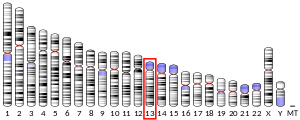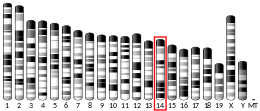Peptide transporter 1

Peptide transporter 1 (PepT 1) also known as solute carrier family 15 member 1 (SLC15A1) is a protein that in humans is encoded by SLC15A1 gene.[5][6] PepT 1 is a solute carrier for oligopeptides. It functions in renal oligopeptide reabsorption and in the intestines in a proton dependent way, hence acting like a cotransporter.[7]
Function
[edit]SLC15A1is localized to the brush border membrane of the intestinal epithelium and mediates the uptake of di- and tripeptides from the lumen into the enterocytes. This protein plays an important role in the uptake and digestion of dietary proteins. This protein also facilitates the absorption of numerous peptidomimetic drugs.[5][7] Peptide transporter 1 functions in nutrient and drug transport have been studied using intestinal organoids.[8][9]
See also
[edit]References
[edit]- ^ a b c GRCh38: Ensembl release 89: ENSG00000088386 – Ensembl, May 2017
- ^ a b c GRCm38: Ensembl release 89: ENSMUSG00000025557 – Ensembl, May 2017
- ^ "Human PubMed Reference:". National Center for Biotechnology Information, U.S. National Library of Medicine.
- ^ "Mouse PubMed Reference:". National Center for Biotechnology Information, U.S. National Library of Medicine.
- ^ a b "Entrez Gene: SLC15A1 Solute carrier family 15 (oligopeptide transporter), member 1".
- ^ Liang R, Fei YJ, Prasad PD, Ramamoorthy S, Han H, Yang-Feng TL, et al. (March 1995). "Human intestinal H+/peptide cotransporter. Cloning, functional expression, and chromosomal localization". J. Biol. Chem. 270 (12): 6456–63. doi:10.1074/jbc.270.12.6456. PMID 7896779.
- ^ a b Adibi SA (July 1997). "The oligopeptide transporter (Pept-1) in human intestine: biology and function". Gastroenterology. 113 (1): 332–40. doi:10.1016/S0016-5085(97)70112-4. PMID 9207295.
- ^ Zietek T, Rath E, Haller D, Daniel H (November 2015). "Intestinal organoids for assessing nutrient transport, sensing and incretin secretion". Scientific Reports. 5 (1): 16831. Bibcode:2015NatSR...516831Z. doi:10.1038/srep16831. PMC 4652176. PMID 26582215.
- ^ Zietek T, Giesbertz P, Ewers M, Reichart F, Weinmüller M, Demir IE, et al. (2020). "Organoids to Study Intestinal Nutrient Transport, Drug Uptake and Metabolism – Update to the Human Model and Expansion of Applications". Frontiers in Bioengineering and Biotechnology. 8: 577656. doi:10.3389/fbioe.2020.577656. PMC 7516017. PMID 33015026.
Further reading
[edit]- Adibi SA (2003). "Regulation of expression of the intestinal oligopeptide transporter (Pept-1) in health and disease". Am. J. Physiol. Gastrointest. Liver Physiol. 285 (5): G779–88. doi:10.1152/ajpgi.00056.2003. PMID 14561585.
- Ganapathy ME, Brandsch M, Prasad PD, Ganapathy V, Leibach FH (1995). "Differential recognition of beta -lactam antibiotics by intestinal and renal peptide transporters, PEPT 1 and PEPT 2". J. Biol. Chem. 270 (43): 25672–7. doi:10.1074/jbc.270.43.25672. PMID 7592745.
- Thamotharan M, Lombardo YB, Bawani SZ, Adibi SA (1997). "An active mechanism for completion of the final stage of protein degradation in the liver, lysosomal transport of dipeptides". J. Biol. Chem. 272 (18): 11786–90. doi:10.1074/jbc.272.18.11786. PMID 9115234.
- Saito H, Motohashi H, Mukai M, Inui K (1997). "Cloning and characterization of a pH-sensing regulatory factor that modulates transport activity of the human H+/peptide cotransporter, PEPT1". Biochem. Biophys. Res. Commun. 237 (3): 577–82. doi:10.1006/bbrc.1997.7129. PMID 9299407.
- Gonzalez DE, Covitz KM, Sadée W, Mrsny RJ (1998). "An oligopeptide transporter is expressed at high levels in the pancreatic carcinoma cell lines AsPc-1 and Capan-2". Cancer Res. 58 (3): 519–25. PMID 9458100.
- Walker D, Thwaites DT, Simmons NL, Gilbert HJ, Hirst BH (1998). "Substrate upregulation of the human small intestinal peptide transporter, hPepT1". J. Physiol. 507 (3): 697–706. doi:10.1111/j.1469-7793.1998.697bs.x. PMC 2230834. PMID 9508831.
- Ashida K, Katsura T, Motohashi H, Saito H, Inui K (2002). "Thyroid hormone regulates the activity and expression of the peptide transporter PEPT1 in Caco-2 cells". Am. J. Physiol. Gastrointest. Liver Physiol. 282 (4): G617–23. doi:10.1152/ajpgi.00344.2001. PMID 11897620.
- Döring F, Martini C, Walter J, Daniel H (2002). "Importance of a small N-terminal region in mammalian peptide transporters for substrate affinity and function". J. Membr. Biol. 186 (2): 55–62. doi:10.1007/s00232-001-0135-9. PMID 11944083. S2CID 11211548.
- Ford D, Howard A, Hirst BH (2003). "Expression of the peptide transporter hPepT1 in human colon: a potential route for colonic protein nitrogen and drug absorption". Histochem. Cell Biol. 119 (1): 37–43. doi:10.1007/s00418-002-0479-y. PMID 12548404. S2CID 7822041.
- Neumann J, Brandsch M (2003). "Delta-aminolevulinic acid transport in cancer cells of the human extrahepatic biliary duct". J. Pharmacol. Exp. Ther. 305 (1): 219–24. doi:10.1124/jpet.102.046573. PMID 12649372. S2CID 34721079.
- Sun BW, Zhao XC, Wang GJ, Li N, Li JS (2003). "Hormonal regulation of dipeptide transporter (PepT1) in Caco-2 cells with normal and anoxia/reoxygenation management". World J. Gastroenterol. 9 (4): 808–12. doi:10.3748/wjg.v9.i4.808. PMC 4611455. PMID 12679938.
- Kulkarni AA, Haworth IS, Lee VH (2003). "Transmembrane segment 5 of the dipeptide transporter hPepT1 forms a part of the substrate translocation pathway". Biochem. Biophys. Res. Commun. 306 (1): 177–85. doi:10.1016/S0006-291X(03)00926-4. PMID 12788085.
- Kulkarni AA, Haworth IS, Uchiyama T, Lee VH (2004). "Analysis of transmembrane segment 7 of the dipeptide transporter hPepT1 by cysteine-scanning mutagenesis". J. Biol. Chem. 278 (51): 51833–40. doi:10.1074/jbc.M308356200. PMID 14532279.
- Uchiyama T, Kulkarni AA, Davies DL, Lee VH (2004). "Biophysical evidence for His57 as a proton-binding site in the mammalian intestinal transporter hPepT1". Pharm. Res. 20 (12): 1911–6. doi:10.1023/B:PHAM.0000008036.05892.e9. PMID 14725353. S2CID 43450358.
This article incorporates text from the United States National Library of Medicine, which is in the public domain.






